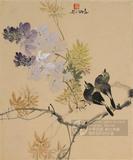宋元集繪 冊 宋韓祐螽斯綿瓞
推薦分享
資源連結
連結到原始資料 (您即將開啟新視窗離開本站)後設資料
- 資料識別:
- 故畫001246N000000013
- 資料類型:
- 類型:繪畫
- 型式:靜態圖像
- 著作者:
- 韓祐
- 主題與關鍵字:
- 南瓜 螽斯.紡織娘
- 出版者:
- 數位化執行單位:國立故宮博物院
- 格式:
- 本幅 25.3x26公分、對幅 25.3x26公分、全幅 43.1x75.9公分
- 關聯:
- 石渠寶笈續編(乾清宮),第一冊,頁513&*故宮書畫錄(卷六),第四冊,頁211&*1.王耀庭,〈韓祐螽斯綿瓞〉,收入國立故宮博物院編輯委員會編,《草蟲畫特展圖錄》(臺北:國立故宮博物院,1986年初版),頁66。 2.劉芳如,〈中國古畫裡的草蟲世界 — 「草蟲天地」特展介紹(下)〉,《故宮文物月刊》,第221期(2001年8月),頁106。 3.邱士華,〈螽斯綿瓞〉,收入何傳馨主編,《文藝紹興:南宋藝術與文化•書畫卷》(臺北:國立故宮博物院,2010年十月初版一刷),頁374。&*韓祐(十二世紀)是江西石城人。南宋紹興年間,曾擔任畫院祇候的職位。他最擅長畫小景和花卉,草蟲則是以林椿為師法的對象。 本幅選自「宋元集繪」冊,描寫田間一角,花葉生長茂盛,瓜果也已熟透,引來了兩隻覓食的螽斯。瓞是指小型的瓜,由於瓜曼能夠綿延生長,且不斷結實,螽斯亦生產力旺盛,因此古人畫此,常蘊含有祝願子孫眾多的吉祥寓意。&*Han Yu, a native of Kiangsi province, served in the painting academy of the Shao-hsing era (1131-1162) under Emperor Kao-tsung. Excelling at small scenes and flowers, his representations of plants and insects followed in the style of Lin Ch'un. This leaf from the album "Collected Sung and Yüan Paintings "shows a melon plant on the ground with grass behind it. This luxuriant plant blossoms and with grass behind it. This luxuriant plant blossoms and has a large ripe fruit that evidently has attracted the attention of two katydids. This kind of small melon has long tendrils and spreads over a large area, continuously bearing fruit. Likewise, the katydid produces many offspring. Thus, when appearing in Chinese painting , they often convey the auspicious wish of having many children.&*本圖題籤標為韓祐所作。韓祐(十二世紀)是江西石城人,南宋紹興年間曾任畫院祇候。圖上並無簽款,或許是因韓祐以草蟲畫聞名,而將此圖歸其名下。無論螽斯或是瓜瓞,都因旺盛的生長與繁殖能力,為祝人子孫眾多具有吉祥寓意的畫題。畫中張牙舞爪地朝小瓜前進的螽斯、放情扭曲擺動的藤蔓捲鬚等物像,則讓人聯想到元代草蟲畫極富戲劇性敘事情節的表現方式,故此作或應視為南宋晚期的草蟲畫作品。(20101015)&*The title slip for this work gives the artist as Han You, a native of Shicheng in Jiangxi who served as an Attendant (zhihou) at the Painting Academy of the Southern Song court during the Shaoxing reign. The painting itself, however, is unsigned, so perhaps it was attributed to Han You on account of his fame in plant-and-insect subjects. Both katydids and melons are known for their prodigious offspring and ability to reproduce, making them popular and auspicious subjects in painting as a blessing for many children. Such motifs as the katydid that appears in a threatening pose on the ground in front of the melon and the lively twisting tendrils of the melon remind one of Yuan dynasty plant-and-insect paintings with their rich and dramatically narrative sentiment. For this reason, the painting here may be a plant-and-insect work of the late Southern Song period.(20101015)
- 管理權:
- 國立故宮博物院
授權聯絡窗口
- 國立故宮博物院圖像授權、出版授權、影音資料授權-申請流程說明
http://www.npm.gov.tw/zh-TW/Article.aspx?sNo=03003061






